Henner Kätelhön, Printing Studio Kätelhön
Auguste-Viktoria-Clinic Bad Oeynhausen, 30/1/1999
about HORST RELLECKE
All good art has the kind of intellectual depth, which you can only feel, not measure, that
challenges one to interact over and over with the images in order to discover the full amount
of telling signs, details and context. This is especially true if you look at the work of Horst
Rellecke. His pictures are not understood at a glance. Rellecke says: "Every picture, every of my
actions has to convey an idea." In another context Paul Wunderlich says it this way: "Who is satisfied
with the technique he has developed (or just taken over)and sticks to it, is dead. The one, who forgets
about his technique and strives for the new, lives." To most of you encountering the artistic work of
Horst Rellecke, a work that given his age is unusually diverse and voluminous, should be a first time
experience. In 1975 Rellecke got a scholarship for print graphics of the Aldegrever Society and worked
in our studios in Wamel. The personal and professional relationship got closer and more stable. 1985
Rellecke finally moved with his family to Wamel. We now have an ongoing and intense exchange of our views.
Having said this, I want to present to you my insights and thoughts concerning the work of Rellecke. Being
just 20 years of age he moulds the very own, unmistakable character of his means of creating. There are no
signs of relying on given styles. He does not start hesitating or insecure like many others. No, he has his
themes and his technique shows soon, without guidance and external help, its own style and orientation.
Relleckes one and only focus are humans and their doings, their behavior and the factual results of their
intellect. Nature, Landscape, Vegetation, reaction to nature you will not find in the work of this artist.
Men, myths and machines. There is no shorter and more valid way to put Relleckes mindset in words. Will
man still master technology and be able to control it in natures best interest? Has technology become in
itself a myth? Does technology bread new technology with no means to stop this? Who serves whom? Are we
standing at the start of a new age with better chances for mankind or are we standing at the end of all times?
Having just a glance at the images of this artist, many mysteries remain. But that's the kick. New doors
to their understanding open slowly, if you deal with his work or single images more frequently. This artists
creativity is always interwoven with humor and also irony. His painting style shows perfect craftsmanship,
but never as a goal itself. Rellecke uses this craftsmanship, wherever in his diverse artistic work, only as
a mean to express his thoughts and his artistic creativity.
At the same time he did his paintings and sculptures,
Rellecke also studied architecture in Stuttgart and got his Ph.D. there. In this field too, he finds his special
orientation. He probes the "force fields", where architecture and art not merely touch or complement, but where
architecture turns into art, where architecture is sculpture. Rellecke is a painter, a sculptor and an architect.
This is the correct sequence. He is no architect who happens to paint too. If Rellecke makes architecture it
will always be sculpture. It has to be a form of fine art. "The glass elephant" in Hamm, build for the first
State Garden Fair in North-Rhine-Westphalia 1984 is a very important document of his mindset. A courageous and
successful example. Again for a State Garden Fair, Oberhausen 1999, he is building the giant Garden-DOM. The
"Glass elephant" had a volume of about 20.000 cbm, while the new building encloses about 138.000 cbm of space,
with building costs of 12,5 Mill. DM. Should Rellecke look a bit nervous to you, it can be accounted to the fact,
that at the 26 of February the festive opening of something is planned, which looks at the moment like a carcass.
Talking of style, a relationship to attributes of surrealism could be detected. One partial definition is a direct
hit...The free creative play as a mean of generating a stream of consciousness...... In the work of Rellecke certain
symbols reoccur all the time: The elephant. What keeps Rellecke so stubbornly close to that animal? With its massive
body this pachyderm is frightening, but he is also friendly and not aggressive. Its the symbol of happiness for
many nations. The pyramid, the sphere, the cube etc.. There meaning isn't just architectural. The scarabaeus . The
flying machine from its beginnings to futuristic versions. With consequence and logic Rellecke shows his drawn,
painted and sculptured world of ideas. I sense a type of philosophy, which searching, scanning for conceptuality,
documents itself as images and sculptures. In tempting aesthetics, confidence, hope, humor, but also fear and doubt
are embedded. Man as a physical being, his psyche, its sensitive reaction to certain pressures resulting from
manmade facts, technological, artistic and architectural ones. Rellecke supersedes the term "time" or chronological
sequence. For him human spirit has a quality independent of time. This becomes obvious in his etching "Ramses and
Leonardo examining the 20th century".
In his new works a urging and molding creativity takes charge even more forceful,
but basically the images have become more joyful and positive. There is progress, there is change. But not much has
changed concerning the inner structures of human life and behavior. In a certain, very peculiar way connections are
made, crossovers: Ikaros – half bird, half flying machine. An airplane moved by an elephants trunk as a propeller.
Metamorphoses of free creativity, which can pretty much puzzle – or just stimulate to have fun with such brain teasers.
I think something the writer Martin Keller said fits especially well concerning Relleckes work: "The art and reality
have only one thing in common, that art has to a reality of its own. That's her freedom."
It is very special though,
that Rellecke for many years now shows a logical consistency in his work. New thoughts are linked to the ones which
already became images. Visions are intermingled with parts of given now a day reality. Inorganic, highly artificial
things relate with the organic and natural. This creates tension and energy. Diverging single elements are bound and
pulled together by a - you could say - tempting basic form, an aesthetic that seduces to look closer and, at first glance,
holds back the dimension of thoughts, of often troublesome truths and visions.
But Rellecke never ponders generalities.
Conscious analysis, meaning to be unequivocal and clear, often cool, is a hallmark of his work. Thanks heaven enough
enigmas and aspects, to be deciphered only individually, remain.
Henner Kätelhön
in January 1999


Zebra-Lady 1972
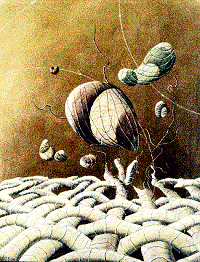
Colored Bubbles) 1973
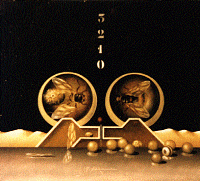
Twin Castle 1976
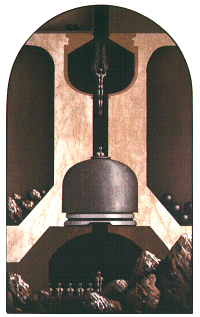
The next please 1979
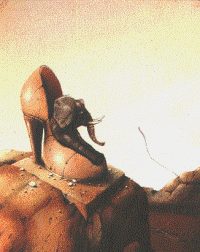
The lonely shepard of
imagination 1980
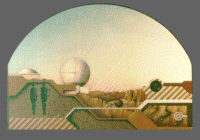
Not built for us 1980
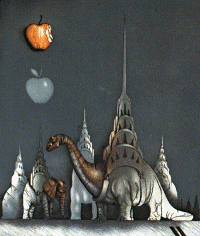
New York 1981
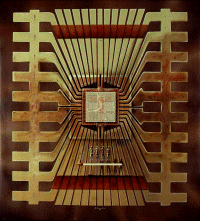
El Dorado 250:1 1983
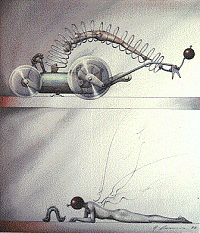
Metamorphoses 1988
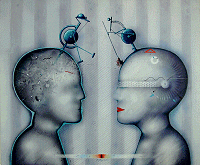
Headache (or eggheads) 1997
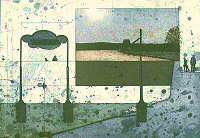
Rain with sunshine